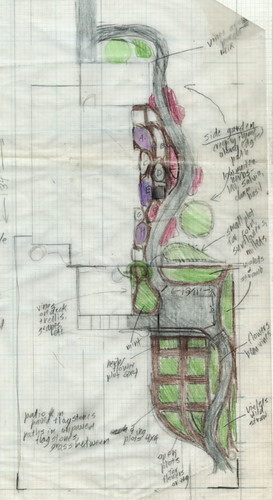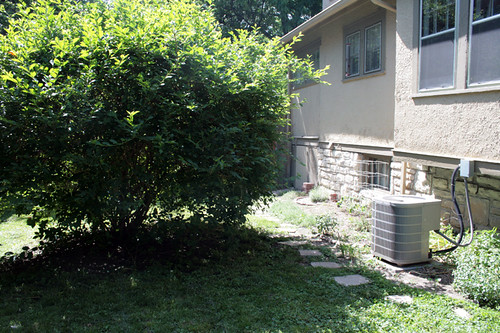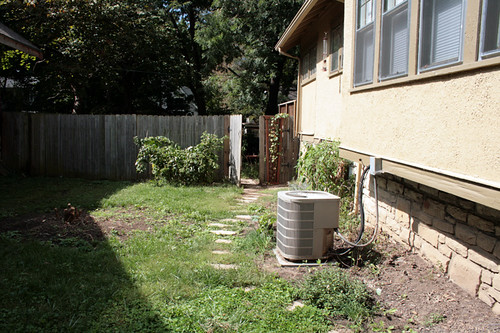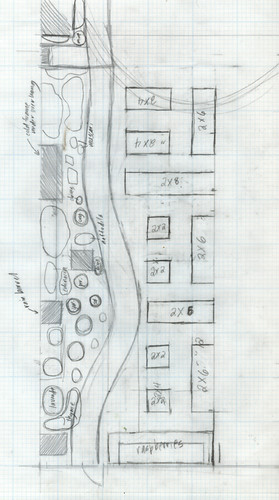 In this entry I'd like to talk about one winter garden chore that's already underway, which is the replanning of the south strip of yard that dominates most of my gardening activity. When we moved into this house, there wasn't much in the way of a garden beyond the somewhat neglected border along the east front walk. The sunny strip of lawn leading to the back gate contained one forsythia bush, lots of spider lilies, and not much else. The backyard was worse, containing only a brick patio and a small untended plot that had maybe been planted with marigolds at some point. I'd complain about weeds, but I've always liked the collection of violets, clover, and mock strawberries that grow throughout our yard. I spent a year holding back and just evaluating the space, deciding what I'd like to do with it. I checked the footprint and boundaries of our lot, measured the details (like bushes, fence, air conditioner, etc.), and in 2007 drew up the plan you see on the left. From the very beginning, I've always shot for a simple, organic design, building everything off a single undulating, snake-like path. While I'm pretty pleased with the execution of the concept overall, I've since realized that I didn't do a very good job accounting for the light conditions throughout the season. While there is a good strong patch of light on the deck and patio throughout the day, most of the backyard is dominated by filtered light throughout the height of the growing season. Of course, you wouldn't see this if you were looking at the backyard in late autumn through early spring, when all the offending trees lack any leaves.
In this entry I'd like to talk about one winter garden chore that's already underway, which is the replanning of the south strip of yard that dominates most of my gardening activity. When we moved into this house, there wasn't much in the way of a garden beyond the somewhat neglected border along the east front walk. The sunny strip of lawn leading to the back gate contained one forsythia bush, lots of spider lilies, and not much else. The backyard was worse, containing only a brick patio and a small untended plot that had maybe been planted with marigolds at some point. I'd complain about weeds, but I've always liked the collection of violets, clover, and mock strawberries that grow throughout our yard. I spent a year holding back and just evaluating the space, deciding what I'd like to do with it. I checked the footprint and boundaries of our lot, measured the details (like bushes, fence, air conditioner, etc.), and in 2007 drew up the plan you see on the left. From the very beginning, I've always shot for a simple, organic design, building everything off a single undulating, snake-like path. While I'm pretty pleased with the execution of the concept overall, I've since realized that I didn't do a very good job accounting for the light conditions throughout the season. While there is a good strong patch of light on the deck and patio throughout the day, most of the backyard is dominated by filtered light throughout the height of the growing season. Of course, you wouldn't see this if you were looking at the backyard in late autumn through early spring, when all the offending trees lack any leaves.I've been asked if it's possible to keep a vegetable garden in filtered or part shade conditions, and the answer is yes...sort of. More experienced gardeners are probably aware that spinach and other types of greens handle shade pretty well. Most other plants will survive at 4-6 hours full sun per day, but after two years of such conditions I can't honestly say they will thrive. Sure, my crops have been productive, but most of the fruits have been small. Not to mention the yields.
I began to think about this last year, concluding that I'd wait another year, see how the crops did, and move the garden if I continued to run into the same setbacks. One of the major problems in a small city lot like ours is finding space with reasonable levels of light, without trees or houses to block the sun. The optimal strip in our yard has always been dominated by the forsythia bush:

Now, I love forsythia bushes as much as the next person, but this one has just been a problem. It's so big that, for the throughway to be at usable, we're forced to trim it back in the late summer when it's sending out new shoots. These trimmings are apparently what's been keeping the bush from producing those gorgeous yellow flowers in early spring. Not that we've had much of a choice.
So, Step #1: Remove forsythia bush. Like so:

Now, I don't recommend removing an overgrown 10+ foot tall forsythia bush unless you absolutely have to. It's not quick, easy, or especially fun. But if you have to, start by trimming down the branches. Cut everything down to the stump. It'll make the rest of the job a lot easier. The only other step is to grab a shovel and dig the thing out. You'll notice that we haven't done this yet, having decided to wait until late winter, when the branches and roots are brittle and some of the plant has (hopefully) died.
 Having cleared up that problem and feeling impatient to begin, I measured the details of the space and began laying the new plan out on paper. Along the strip where the bush had been, now covered in grass, I wanted to set new boxes where they would get optimal light and use roughly the same amount of square feet as in my current space. While it would have been convenient to move all the boxes we built in 2007 straight to the new space, the restrictions prevented that from being a possibility. I spent an hour or two sketching out rectangles on tracing paper before arriving at the final plan on the right. The skinny 2' wide raised beds turned out to be a lot more flexible in the narrow strip in terms of space, and they're also easier than the 4'x4' raised beds to reach into (for a shorty like me, at least). I was able to eke out roughly the same square footage and will be adding a box around the raspberry, which is one of the easiest ways to manage the brambles. Between the boxes, I will have the same 2' wide paths, possibly covered with landscape fabric or mulch (I haven't really decided). I'm trying this time to avoid removing large tracts of sod, since it's back-breaking work and not absolutely necessary when planting in boxes. Many potager and square-foot gardeners simply lay something at the bottom of the box to block out weed and tree growth. The hardest part of this new plan will be dismantling and rebuilding boxes from scrap and building new ones as needed. Not to mention moving the layers of soil and compost I've built in the last two years. Honestly, I'm looking forward to all the work ahead of me this spring. I hope it will bring me closer to my goal of producing a more substantial portion of my own food.
Having cleared up that problem and feeling impatient to begin, I measured the details of the space and began laying the new plan out on paper. Along the strip where the bush had been, now covered in grass, I wanted to set new boxes where they would get optimal light and use roughly the same amount of square feet as in my current space. While it would have been convenient to move all the boxes we built in 2007 straight to the new space, the restrictions prevented that from being a possibility. I spent an hour or two sketching out rectangles on tracing paper before arriving at the final plan on the right. The skinny 2' wide raised beds turned out to be a lot more flexible in the narrow strip in terms of space, and they're also easier than the 4'x4' raised beds to reach into (for a shorty like me, at least). I was able to eke out roughly the same square footage and will be adding a box around the raspberry, which is one of the easiest ways to manage the brambles. Between the boxes, I will have the same 2' wide paths, possibly covered with landscape fabric or mulch (I haven't really decided). I'm trying this time to avoid removing large tracts of sod, since it's back-breaking work and not absolutely necessary when planting in boxes. Many potager and square-foot gardeners simply lay something at the bottom of the box to block out weed and tree growth. The hardest part of this new plan will be dismantling and rebuilding boxes from scrap and building new ones as needed. Not to mention moving the layers of soil and compost I've built in the last two years. Honestly, I'm looking forward to all the work ahead of me this spring. I hope it will bring me closer to my goal of producing a more substantial portion of my own food.As far as the space left over when the vegetable garden is moved...well, I'll be working on replanning that this winter as well. As mentioned in my previous blog, I'd like to create a beautiful woodland habitat of mostly native plants with some edibles thrown in. More on that in the future!